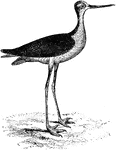
Stilt
"Himantopus. Stilts. Bill extremely slender, but not flattened, nor turned up, nor hooked; longer than…

Black-necked Stilt
"Stilt. Long-shanks. Lawyer. Adult. Mantle, constituted by the interscapulars, scapulars, and wings…

Wilson's Phalarope
"Steganopus wilsoni. Wilson's Phalarope. Bill and feet black. Crown of head pale ash, passing into white…
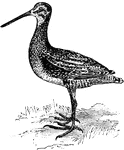
Small Wilson's Snipe
"Gallinago wilsoni. American Snipe. Wilson's Snipe. "English" Snipe. Jack-Snipe. Crown black, with a…
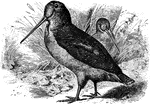
American Woodcock
"Philohela minor. Woodcock. Bog-sucker. Colors above harmoniously blended and varied black, brown, gray,…

Wilson's Snipe
"Gallinago wilsoni. American Snipe. Wilson's Snipe. "English" Snipe. Jack-Snipe. Crown black, with a…

Probing American Woodcock
"Philohela minor. Woodcock. Bog-sucker. Colors above harmoniously blended and varied black, brown, gray,…
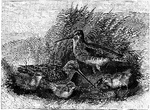
Family of Snipes
"Gallinago wilsoni. American Snipe. Wilson's Snipe. "English" Snipe. Jack-Snipe. Crown black, with a…
Red-breasted Snipe Head
"Macrorhamphus griseus. Red-breasted Snipe. Gray Snipe. Brown-back. Dowitcher. In summer:Under parts…
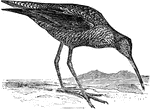
Stilt Sandpiper
"Micropalama himantopus. Stilt Sandpiper. In summer: blackish, each feather edged and tipped with white…
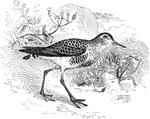
Sanderling
"Calidris arenaria. Sanderling. Ruddy "Plover". Adult in summer: Entire upper parts and neck all round…
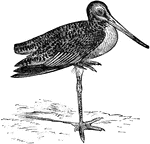
Marbled Godwit
"Limosa fedoa. Great Marbled Godwit. Marlin. Feathers not extending on side of lower mandible to a point…

Willet Head
"Symphemia semipalmata. Semipalmated Tattler. Willet. Adult in summer: Upper parts ashy, confoundedly…
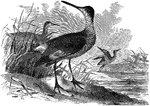
Willets
"Symphemia semipalmata. Semipalmated Tattler. Willet. Adult in summer: Upper parts ashy, confoundedly…

Greater Yello-shanks
"Totanus melanoleucus. Greater Tell-tale. Greater Yellow-shanks. Long-legged Tattler. Stone-snipe. Bill…

Solitary Sandpiper
"Rhyacophilus solitarius. Solitary Tattler. American Green Sandpiper. Solitary Sandpiper. Above, dark…

Spotted Sandpiper
"Tringoides macularius. Spotted Sandpiper. Above, silken ashen-olive (quaker-color- as in our cuckoos)…
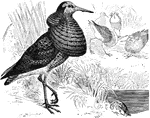
Ruff
"Machetes pugnax. Ruff. Reeve. Combatant. Gambetta. Varied above with black, brown, buff and chestnut,…

Buff-breasted Sandpiper
"Tryngites rufescens. Buff-breasted Sandpiper. Above, brownish-black with a greenish gloss, every feather…
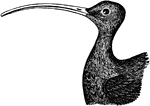
long-billed Curlew
"Numenius longirostris. Long-billed Curlew. Sickle-bill. Plumage very similar to that of the Godwit,…
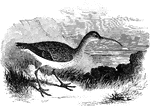
Hudsonian Curlew
"Numenius hudsonicus. Hudsonian Curlew Jack Curlew. General tone of coloration scarcely rufous, the…
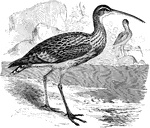
Eurasian Curlew
"Numenius arquatus. Eurasian Curlew. European Curlew. Bill of very variably length, always longer than…
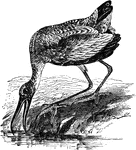
Wood Ibis
"Tantalops loculator. American Wood Stork. Wood Ibis. Colorado Turkey. Plumage white, the wing-quills,…
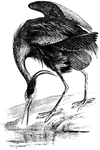
Great Blue Heron
"Ardea herodias. Great Blue Heron. Of large size, and varied dark colors, not dichromatic. Back without…
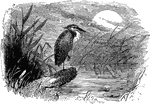
Night Heron
"Nyctiardea grisea naevia. Black-crowned Night Heron. Qua-bird. Squawk. Crown, scapulars and interscapulars…
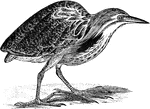
American Bittern
"Botaurus mugitans. American Bittern. Indian Hen. Stake-driver. Bog-Bull. Plumage of the upper parts…
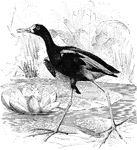
Parra Jacana
"Parra. Jacanas. Bill plover-like, contracted in continuity, enlarged terminally; with culmen depressed…

Clapper Rail
"Rallus longirostris crepitans. Clapper Rail. Salt-water Marsh-hen. Mud-hen. Above, variegated with…
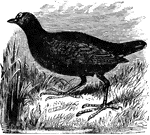
Gallinule
"Gallinula. Gallinules. Water Hens. Mud Hens. Bill not longer than head, stout at base, tapering, compressed,…
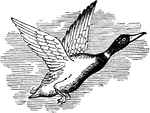
Wild Duck
"Anus boscas. Mallard. Wild or Domestic Duck. Green-head. Bill greenish-yellow. Feet orange-red. Iris…
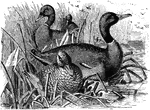
Mallards
"Anus boscas. Mallard. Wild or Domestic Duck. Green-head. Bill greenish-yellow. Feet orange-red. Iris…

Mute Swan
"Cygynus. White Swans. Neck of extreme length. Trachea normally entering sternum. Bill tuberculate or…
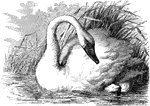
Whistling Swan
"Cygnus columbianus. Common American Swan. Whistling Swan. Bill with a yellow spot or blotch in front…

Black Brant Head
"Bernicla nigricans. Black Brant. Bill, feet, and claws black; iris brown. Head and neck all around,…

Black Brant
"Bernicla nigricans. Black Brant. Bill, feet, and claws black; iris brown. Head and neck all around,…
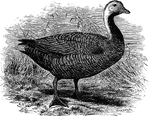
Emperor Goose
"Philacte canagica. Painted Goose. Emperor Goose. Wavy bluish-gray, with lavender or lilac tinting,…
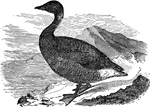
Common Brant
"Bernicla brenta. Brant Goose. Bill, feet, and claws black; iris brown. Head and neck all around, and…
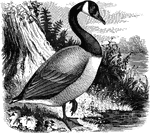
Canada Goose
"Bernicla canadensis. Canada Goose. Common Wild Goose. Tail normally 18-feathered. Bill, feet, head,…

Pin-tail Duck Head
"Dafila. Pin-tail Ducks. Tail (in adult male) narrow, cuneate, when fully developed nearly as long as…

Pin-tail Ducks
"Dafila acuta. Pin-tail Duck. Sprig-tail. Bill black, with grayish-blue edge of upper mandible; feet…
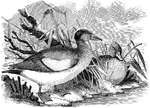
American Wigeon
"Mareca americana. American Wigeon. Bald-pate. Bill grayish-blue, with black tip and extreme base; feet…

Northern Shoveler
"Spatula clypeata. Shoveller Duck. Broad-bill. Bill blackish; iris orange-red: feet vermilion-red. Head…

Small Redhead
"Fuligula ferina americana. Red-head. American Pochard. The feathers of the head somewhat full and puffy,…
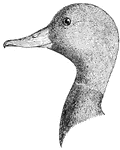
Large Redhead
"Fuligula ferina americana. Red-head. American Pochard. The feathers of the head somewhat full and puffy,…
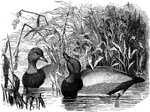
Redheads
"Fuligula ferina americana. Red-head. American Pochard. The feathers of the head somewhat full and puffy,…

Labrador Duck
"Camptolaemus labradorius. Labrador Duck. Pied Duck. Adult male: Bill black with orange at base and…
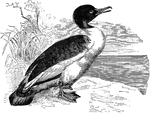
Merganser
"Mergus merganser. Merganser. Goosander. Nostrils near middle of bill. Frontal feathers extending acutely…

Double-crested Cormorant
"Phalacrocorax dilophus. Double-crested Cormorant. Tail of 12 feathers. Gular sac convex behind. No…

White-headed Gull Head
"Larus heermanni. White-headed Gull. Bill shorter than head or tarsus, rather slender, moderately compressed,…

Roseate Tern
"Sterna dougalli. Roseate Tern. Paradise Tern. Bill about as long as head or foot, straight, slender,…
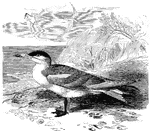
Caspian Tern
"Sterna (T.) caspia. Caspian Tern. Imperial Tern. Bill dark vermilion red, growing and somewhat "diaphanous"…

Royal Tern
"Sterna (T.) maxima. Cayenne Tern. Royal Tern. Adult in summer: Pileum glossy greenish-black, not extending…
Elegant Tern
"Sterna (T.) elegans. Elegant Tern. Princely Tern. Bill bright red, salmon-colored toward tip. Feet…

Sandwich Tern
"Sterna (T.) cantiaca. Sandwich Tern. Ducal Tern. Bill black, the tip 1/2 to 3/4 an inch bright yellow,…

Tail of Forster's Tern
"Sterna forsteri. Forster's Tern. Tail 5.00 - 8.00, forked 2.50-5.00." Elliot Coues, 1884

Aleutian Tern
"Sterna aleutica. Aleutian Tern. Bill of ordinary shape, as in hirundo, macrura, etc., entirely black.…
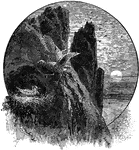
Fulmar and Nest
"Fulmarus. Fulmar. Adult: White; mantle pale pearly-blue, restricted to back and wings, or extending…
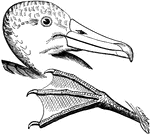
Bill and Foot of a Short-tailed Albatross
"Diomedea brachyura. Short-tailed Albatross. Bill 5.00 or 6.00 inches long, with long, with moderately…

Sooty Albatross
"Phoibetria fuliginosa. Sooty Albatross. Plumage ordinarily uniform sooty-brown; quills and tail blackish…

Slender-billed Fulmar
"Priocella tenuirostris. Slender-billed Fulmar. Adult: Plumage white, with clear pearly-blue mantle,…